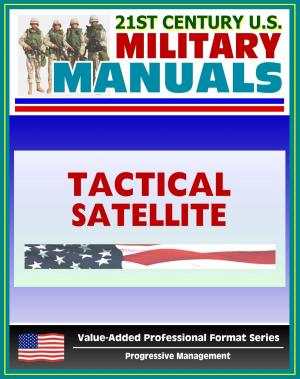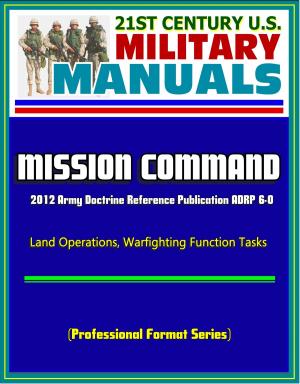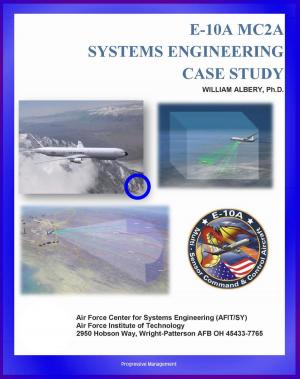21st Century U.S. Military Manuals: Corps Operations FM 3-92 (FM 100-15) - Headquarters Organization, Command Post and Cell, Full Spectrum Operations (Professional Format Series)
Nonfiction, History, Military, United States| Author: | Progressive Management | ISBN: | 9781301234721 |
| Publisher: | Progressive Management | Publication: | February 2, 2013 |
| Imprint: | Smashwords Edition | Language: | English |
| Author: | Progressive Management |
| ISBN: | 9781301234721 |
| Publisher: | Progressive Management |
| Publication: | February 2, 2013 |
| Imprint: | Smashwords Edition |
| Language: | English |
Professionally converted for accurate flowing-text e-book format reproduction, this Army Field Manual - issued in November 2010 - provides direction for the corps headquarters: what it looks like, how it is organized, how its staff operates, how it is commanded and controlled, and how it operates in full spectrum operations. This publication replaces the previous edition of the Army's corps operations manual and describes the organization and operations of the corps. It reflects current doctrine on the elements of full spectrum operations: offense, defense, and stability or civil support. This manual addresses these elements without regard to priority. This manual
• Incorporates the Army's operational concept, full spectrum operations.
• Describes the stand alone corps headquarters.
• Links brigade combat team and division doctrine with theater army doctrine. It describes the principles underlying the Army modular corps.
• Shows a corps headquarters designed for four primary employment roles—in priority—an Army intermediate tactical headquarters, an ARFOR, a joint force land component command headquarters, and a joint task force headquarters.
• Recognizes that the corps headquarters normally requires augmentation with elements from theater-level organizations for selected missions.
• Discusses when serving as a joint task force or joint force land component command, the corps may require a separate subordinate headquarters to serve as the ARFOR or may need augmentation to serve as both the joint headquarters and the ARFOR.
• Introduces a staff organization that reflects the warfighting functions discussed in Field Manual (FM) 3-0.
• Describes the three designated command and control facilities: main command post, tactical command post, and mobile command group.
Corps Operations * Contents * PREFACE * INTRODUCTION * Chapter 1 * THE CORPS * The Joint Environment * The Corps Headquarters * Available Forces * Chapter 2 * CORPS HEADQUARTERS * Section I - Corps Headquarters Organization * Command Group * Command Post Cells and Other Command Post Organizations * Section II - Main Command Post * Coordinating, Special, and Personal Staff Officers * Main Command Post Functional Cells * Main Command Post Integrating Cells * Section III - Tactical Command Post * Intelligence Cell * Movement and Maneuver Cell * Fires Cell * Protection Cell * Sustainment Cell * Command and Control Cell * Section IV - Additional Command and Control Facilities * Mobile Command Group * Early-Entry Command Post * Centers * Section V - Air Force Support to the Corps * Section VI - Corps Headquarters and Headquarters Battalion * Battalion Command Group * Battalion Staff * Headquarters Support Company * Operations Company * Intelligence and Sustainment Company * Signal Company * Civilian, Contractor, and Other Augmentation * Chapter 3 * CORPS HEADQUARTERS OPERATIONS * Support to Corps Headquarters * Command and Support Relationships * Command and Control * Battle Rhythm * Chapter 4 * THE CORPS IN FULL SPECTRUM OPERATIONS * Employing the Corps * Synchronizing Information Actions * Applying the Elements of Combat Power * Chapter 5 * CORPS HEADQUARTERS TRANSITION TO A JOINT TASK FORCE HEADQUARTERS * The Joint Force * The Transition Training Life Cycle * Joint Task Force Headquarters Organization * Augmentation to the Corps Headquarters * Other Augmentation or Collaborative Capabilities * Joint Task Force Headquarters Equipping Capabilities * Joint Land Operations * Appendix A * SUSTAINMENT
Professionally converted for accurate flowing-text e-book format reproduction, this Army Field Manual - issued in November 2010 - provides direction for the corps headquarters: what it looks like, how it is organized, how its staff operates, how it is commanded and controlled, and how it operates in full spectrum operations. This publication replaces the previous edition of the Army's corps operations manual and describes the organization and operations of the corps. It reflects current doctrine on the elements of full spectrum operations: offense, defense, and stability or civil support. This manual addresses these elements without regard to priority. This manual
• Incorporates the Army's operational concept, full spectrum operations.
• Describes the stand alone corps headquarters.
• Links brigade combat team and division doctrine with theater army doctrine. It describes the principles underlying the Army modular corps.
• Shows a corps headquarters designed for four primary employment roles—in priority—an Army intermediate tactical headquarters, an ARFOR, a joint force land component command headquarters, and a joint task force headquarters.
• Recognizes that the corps headquarters normally requires augmentation with elements from theater-level organizations for selected missions.
• Discusses when serving as a joint task force or joint force land component command, the corps may require a separate subordinate headquarters to serve as the ARFOR or may need augmentation to serve as both the joint headquarters and the ARFOR.
• Introduces a staff organization that reflects the warfighting functions discussed in Field Manual (FM) 3-0.
• Describes the three designated command and control facilities: main command post, tactical command post, and mobile command group.
Corps Operations * Contents * PREFACE * INTRODUCTION * Chapter 1 * THE CORPS * The Joint Environment * The Corps Headquarters * Available Forces * Chapter 2 * CORPS HEADQUARTERS * Section I - Corps Headquarters Organization * Command Group * Command Post Cells and Other Command Post Organizations * Section II - Main Command Post * Coordinating, Special, and Personal Staff Officers * Main Command Post Functional Cells * Main Command Post Integrating Cells * Section III - Tactical Command Post * Intelligence Cell * Movement and Maneuver Cell * Fires Cell * Protection Cell * Sustainment Cell * Command and Control Cell * Section IV - Additional Command and Control Facilities * Mobile Command Group * Early-Entry Command Post * Centers * Section V - Air Force Support to the Corps * Section VI - Corps Headquarters and Headquarters Battalion * Battalion Command Group * Battalion Staff * Headquarters Support Company * Operations Company * Intelligence and Sustainment Company * Signal Company * Civilian, Contractor, and Other Augmentation * Chapter 3 * CORPS HEADQUARTERS OPERATIONS * Support to Corps Headquarters * Command and Support Relationships * Command and Control * Battle Rhythm * Chapter 4 * THE CORPS IN FULL SPECTRUM OPERATIONS * Employing the Corps * Synchronizing Information Actions * Applying the Elements of Combat Power * Chapter 5 * CORPS HEADQUARTERS TRANSITION TO A JOINT TASK FORCE HEADQUARTERS * The Joint Force * The Transition Training Life Cycle * Joint Task Force Headquarters Organization * Augmentation to the Corps Headquarters * Other Augmentation or Collaborative Capabilities * Joint Task Force Headquarters Equipping Capabilities * Joint Land Operations * Appendix A * SUSTAINMENT















